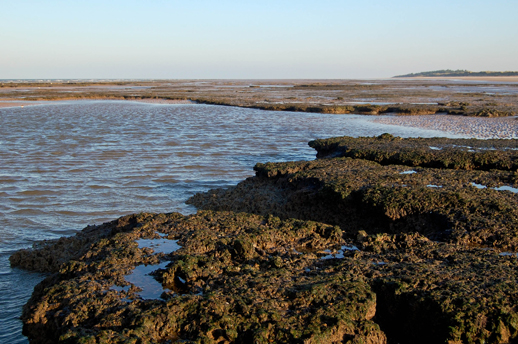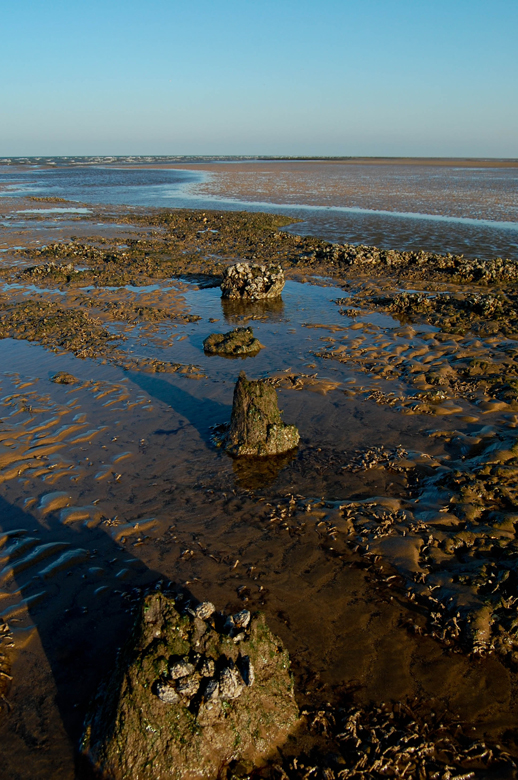
by Danny Adcock.
As I crest the dunes a flock of fieldfares take flight, and lifting from the spiked sea-buckthorn bushes circle back behind me over the golf course. The distant tide is visible, but only just. There’s a stillness to the morning that stretches out across the landscape. The sky and horizon blend in a monochrome grey wash.
These sand dunes mark the point where the cultivation of the land ceases, and the cold harshness of the North Sea begins. At this time of year it can be a very harsh environment: the carcass of a young seal lies empty-eyed amongst the driftwood. When the north wind blows it not only brings piercing temperatures, but many species of rare migrant birds. The Norfolk Ornithologist’s Association has a reserve here, and it is designated a Site of Special Scientific Interest as is much of this coastline. This is Holme-Next-The-Sea, at the end of the historic Peddars Way, on the curve of Norfolk coast where the Wash becomes the North Sea. Holme is a small village; at its heart a fifteenth century church, and seventeenth century pub. It has been a destination for travellers far longer than ale has been served behind the bar of The White Horse: the Peddars Way follows the line of a Roman road dating to A.D. 61. It was built following the defeat of Boudicca and intended as an aid to keeping the locals in check. Who’s to say, though, that the Romans didn’t just follow the course of an older track? Ancient Britons were far from being the barbarians that the Roman chroniclers made us out to be, and before the Romans, two thousand years before the Romans, there was something at Holme which Bronze Age people might have travelled a very long way to see.
Leaving the dunes behind and all signs of civilisation are obscured. The golf course that lies between the village and the sea vanishes below the marram grass. It is very apt that all trace of modernity has vanished for before me stretches out an ancient landscape; a landscape that has the footprint of our ancestors etched deep into it. As I leave the high tide mark behind me I’m walking further and further from the present, and into the past.
The sand at the top of the beach gives way to mud and then becomes sand once more. Then, disconcertingly, the sand bank gives way to more compacted sand and there’s a gully running parallel to the shore. When the tide reappears it will fill this gully with water four or five feet deep. The R.N.L.I. has a hovercraft at Old Hunstanton to rescue unwary souls who stray on the sands, and get cut off by the tide.
Shelving gently downwards again, the sand is sculpted and corrugated by the tide. The quietness surrounding me is punctuated by the objections to my presence of the various species of wader which make a living here. Interrupted from their breakfast their frustration is understandable: they have a few hours to feed before the returning sea pushes them off the best feeding grounds.
Further from the shore, I’m approaching a collection of large black masses emerging from the sand. Where they are closer to the land they seem to ease gently from the thousands of years of sediment laid down by countless billions of waves. The further from the beach the harsher their edges become until some are two, or even three, feet high. They stretch along the beach into the distance. Some are higher than others, some are linked together, some stand alone. The beach is pock-marked with them, creating pools that capture the tide, and channels that allow it to escape. The seaward edges are etched sharply upwards, and undercut by the waves’ twice daily compulsion.

A few years ago these peat beds, for that is what they are, were the site of an amazing discovery. From beneath them an extraordinary Bronze Age wooden circle appeared. Not as spectacular as Stonehenge perhaps, but in its own way just as enigmatic, Seahenge, as it became known, emerged into the twentieth century almost unseen. Gradually, with the relentlessness of the tide and the weather, it grew to captivate, to move, and to polarise opinion not only locally, but nationwide. Consisting of fifty-five mud and time-blackened oak stumps arranged circularly around a large upturned root, also of oak, the structure created much controversy between those who wanted to remove and preserve it, and those who wanted it left in-situ. Leaving it would have resulted in its destruction; the exposure to the air, and thousands of organisms that live in this environment, as well as the waves and the weather, meant it was disappearing as soon as it appeared.
Dendrochronological analysis revealed it to be four thousand years old. The technique is so accurate it is able to tell us that, in fact, it was Spring or Summer of the year 2049 B.C. when the one-hundred-and-sixty-seven-year-old oak that formed the centrepiece was felled. Archaeologists worked out a single axe was used to fell this tree, but that up to fifty were used to fell the other trees.
It would have been a very different landscape then: the shoreline was several miles further out, and Seahenge would have stood between the sea and the land. Its purpose remains unclear, but it presumably would have had some sort of ritualistic purpose. The site was discovered to be much larger than originally thought; remains of causeways and further circular structures were revealing themselves, but English Heritage, who did excavate and remove all fifty six timbers of the original circle, decided to leave these to the elements.
Though no trace of Seahenge remains on Holme beach now – it is on display in King’s Lynn museum – the landscape still holds an atmosphere of fascination for me; as I walk across the peat I am walking in the very footsteps of ancient man. The peat still gives up glimpses of the past: timbers are visible all around me. Not being an archaeologist I don’t know whether they are the shards of relatively modern boats, driftwood, or the remains of something far older: a tangible, touchable link to our past.
One in particular catches my attention. Covered in bark as black as ink, it juts about three feet from the peat at a slight angle, and is remarkably similar to the timbers on display in King’s Lynn museum. How deep it is embedded I don’t know, but it is immovable. Was it placed purposely in that position? Is it just a bit of old tree that the tide brought in, and somehow became lodged in the sand and mud at a strange angle? Here and there even tree roots are visible as a remarkable testament to how capable the peat is of preserving these splinters from the past. Fingering the bark I wonder whether ancient fingers didn’t touch this very spot, and whether a family or community stood here to mourn a loved one, or celebrate a harvest.
Mussels lie in huge numbers on the peat beds. The builders of Seahenge would probably have gathered them like I do; a free and delicious source of food. How many generations of these shellfish lie between me and them is quite unfathomable, but though four thousand years is a very long time, we still hold links with our past that prove us to be remarkably similar, in some aspects, to the builders of Seahenge.
The tide is beginning to surge up the beach with surprising speed, and is already engulfing the peat beds that lie furthest from the shore. A flock of snow buntings flit along the tide line as I head back. When I reach the car park a group of twitchers are about to set off the way I have come: four thousand years back in time. I wonder if any of them are aware of the ancientness of the landscape they are about to enter?